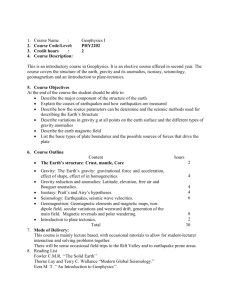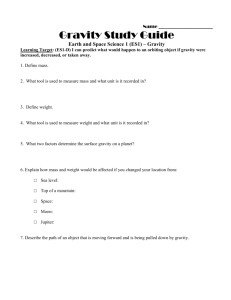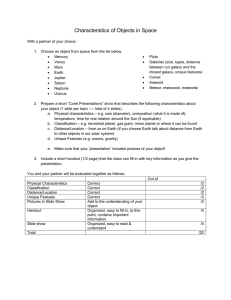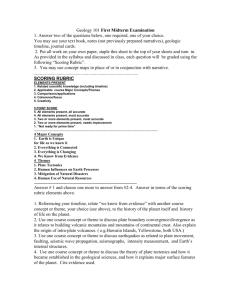Introduction to Earth System
advertisement
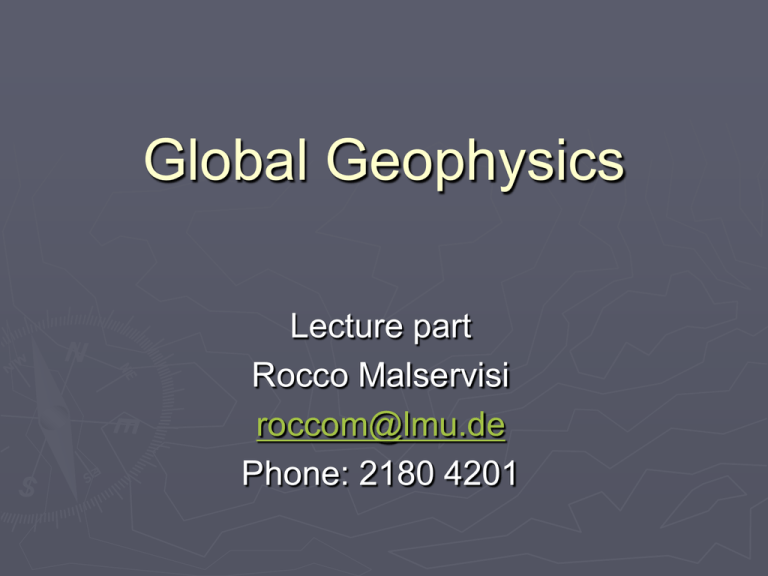
Global Geophysics Lecture part Rocco Malservisi roccom@lmu.de Phone: 2180 4201 NASA photo from Apollo 17 Is it really a sphere? Is it an ellipsoid? Is it flat? The shape of our system depend on the problem we want to study and the required precision!! How big is the planet? By definition 40000 km!! 1m=1/4e6 length of a meridian. Or 60x360 nautical miles (21600 nm). How big is the planet? By definition 40000 km!! The first one to measure it correctly Erstosthenes measuring the distance from Alexandria and Syene (5000 stadia) and the angles in figure, he computed a circumference of 250000 stadia 39300km From Marshak, 2005 How big is the planet? By definition 40000 km!! Today we say that the radius of the Spherical Earth equivalent to the volume of the planet is: 6371 km We also know that an ellipsoid is a better approximation: Eq radius: 6378 km Pol Radius: 6356 km Flattening: 1/298 From Marshak, 2005 We are attracted to it and there is gravity http://www.jadetower.org/muses/wlsimages/gravity-newton.jpg We are attracted to it and there is gravity And if we look at the satellite it is “falling in to the Earth” attracted by a force that is proportional to the mass of the planet. From the orbit parameter we can compute the mass http://www.jadetower.org/muses/wlsimages/gravity-newton.jpg Well even from the ground if we know the constant G and our distance from the center of the Earth we can measure the gravity acceleration thus the mass of the Earth (ex a pendulum) M=gR2/G g=9.8ms-2 G=6.67e-11 m3kg-1s-2 R=6371km M=6e24 kg http://www.jadetower.org/muses/wlsimages/gravity-newton.jpg So can we say something about the interior of the planet? what is the average density? Mass = 6e24 kg Volume = ? So what is the average density? Mass 6e24 kg Volume=4/3pR3= 1.08e21 m3 So its density is ~5500 kg m-3 Density of surface rocks? So what is the average density? Mass 6e24 kg Volume=4/3pR3= 1.08e21 m3 So its density is ~5500 kg m-3 Density of surface rocks? ~1.5-3.5 g/cc Density Iron ~7g/cc http://earthguide.ucsd.edu/mar/dec5/earth.html Which shape has the planet? What can we see (colors)? What can we measure? We have a magnetic field that it is very similar to the one of a dipole. Magnetopause 10Re Moon 60Re Well in reality this is true close to the surface if we go far away enough it looks more complex Variation of Magnetic field on oceans Looking for subs the British and Americans developed a map of Magnetic anomalies of the sea floor, in 1961 Harry Hess explained It using seafloor spreading theory. Müller et al. 2006 Magnetic and gravity anomalies and topo/bathymetry GGM01S, GRACE mission www.csr.utexas.edu/grace/gravity/ Let’s try to look more in details the brownish regions Some Somearea areasare look flat like and ifsome someone are rough enjoyed Some area are more brownish then other to fold it Let’s try to look more in details the gravity What does influence this variation of gravity field? So as first approximation the Earth is a planet that looks like a sphere with a density higher than we would expect looking only at the surface, with regions of different colors at the surface and able to generate a dipolar magnetic field. That does not appear to be constant. So it does not look any longer as an homogeneous sphere!! On second approximation it is an ellipsoid 6357 km (polar) 6378 km (equatorial) And it looks like if some processes are shaping the brownish regions…. We will spend the rest of the semester to look at these processes and to figure out how we can observe them PLATE TECTONICS Plate Tectonic is a theory that unify different previous geological theories (CONTINENTAL DRIFT and OCEAN SPREADING) and that can explain the majority of the solid earth system observations. Basic concept: The outermost layer (LITHOSPHERE) is divided in a small number of “rigid” plates in relative motion one respect to the other and that are moving on a weak ASTHENOSPHERE PLATE TECTONICS Basic concept: The outermost layer (LITHOSPHERE) is divided in a small number of “rigid” plates in relative motion one respect to the other and that are moving on a weak ASTHENOSPHERE Basic Assumptions: The astenosphere viscosity is low enough to allow on long time scale for viscous flow; The generation of new plate material occurs by sea floor spreading; The new oceanic lithosphere form part of a rigid plate that may or may not include continental material; Earth’s surface area remains constant; this means that seafloor spreading must be balanced by consumption of plate elsewhere; Lithospheric plate are capable of transmitting stress over great horizontal scale. In other words plates are rigid and the deformation is concentrated along the boundaries.




